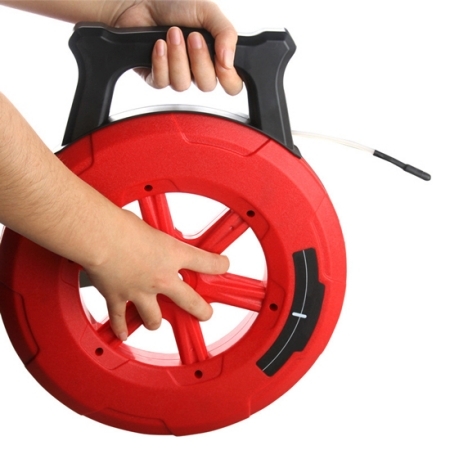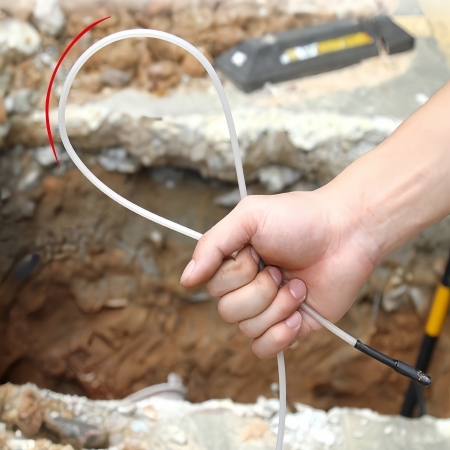Using the pipe blockage detector is a simple process. The purpose is to find the detection point of the blockage. Following the correct operation method will help to quickly find the detection point and solve the blockage problem as soon as possible.

The first step is to check the pipe finder to ensure that all functions of the blockage detector are normal. Press and hold the power button to turn on the transmitter and receiver. Adjust the sensitivity of the receiver's round knob to the maximum, and then approach the transmitter. If the receiver can make a strong "buzzing" sound, it means that the instrument is normal; otherwise, you need to remove the outer rubber sleeve of the transmitter to check whether the probe is disconnected or faulty.
The second step: After ensuring that the pipe blockage detector can work properly, turn the wire reel clockwise and extend the waterproof probe into the pipe until the probe reaches the blockage point. (Counterclockwise can retract the signal line.) Therefore, it is necessary to purchase a blockage detector with a suitable signal line length to be more convenient in use. SISCO online store will help you simplify the process of selecting a thermal imaging camera, ensuring that you make an informed decision that meets your specific needs.
The second step is to use the detector to find the blockage point. Hold the detector and place it flat on the wall, floor, or ground where you suspect the pipe may be located, then move slowly, paying attention to the double signal reminder of the buzzer and flash. It should be noted that the closer you are to the blockage point, the greater the signal strength. Therefore, the closer you are to the sensing probe, the louder the buzzer alarm will be, and the loudest buzzer is where the probe is located.
The third step is to lower the sensitivity switch after finding the blockage point to determine the exact location. This can help optimize the performance of the detector and is also a key link in ensuring the safe operation of the pipeline system. At this time, you can mark the detected blockage location, pull out the transmitting probe, and prepare for subsequent repair operations. If necessary, you can repeat the process from different angles to confirm the exact location of the pipeline.
It is worth mentioning that many operators may often forget to adjust the sensitivity during the detection process. This is an important step when using a pipeline blockage detector, mainly because the working principle of a pipeline blockage detector usually involves the use of sensors and circuits to detect blockages in the pipeline and indicate the location and degree of blockage through an alarm system or display device. Under different pipeline conditions, the degree of blockage will also vary, from slight partial blockage to complete blockage. For pipeline blockage detectors, the measuring distance between the transmitter and the receiver will be reduced due to the obstruction of the objects in the middle. Therefore, although using a pipeline blockage detector is a relatively simple process, the key is to determine the location and condition of the blockage point.
Before the operator finds the blockage point, it is necessary to use a high-sensitivity gear to determine the approximate range. After finding the approximate range of the blockage point, use a low-sensitivity gear to narrow the range of the blockage point, ensuring that the blockage detector can accurately identify and handle blockages of different severity, and can provide corresponding alarm levels to avoid false alarms or missed alarms due to differences in pipeline characteristics, so that operators can judge the severity of the blockage according to the intensity of the alarm and take corresponding treatment measures.
Replace the Probe
The probe of the pipeline blockage detector is one of its core components. It is responsible for directly contacting the medium in the pipeline and sensing changes in the pipeline. With long-term use and the influence of environmental factors, the probe may lose its original sensitivity and accuracy due to physical wear, chemical corrosion, or damage by foreign objects in the pipeline. Once the probe is damaged, the pipeline blockage detector will not be able to accurately detect the blockage of the pipeline, which will greatly affect the safe operation of the entire pipeline system. Therefore, timely replacement of the accessories of the pipeline blockage detector and following the correct operating procedures can ensure its good working condition.

Step 1: Check the status of the connecting wire and the probe. Make sure that the connecting wire is not damaged or broken and that the connection is firm. If the probe is blocked or dirty, you can use a cleaning cloth or cotton swab to gently clean the probe to remove dirt that may interfere with the installation of the new probe.
Step 2: Make sure that the pipe blockage detector is turned off and disconnected from any power source, and trim the damaged probe. Check the new probe for any visible damage and defects.
Step 3: Pull out the end of the signal line and trim the two copper wires of the signal line to the appropriate length.
Step 4: Put a thin copper tube on the trimmed signal line mouth, use pliers to clamp the thin copper tube near the bottom of the wire head, and cut the length of the probe wiring to 5mm, put on 2mm heat shrink tubes respectively, and then put the probe into the copper tube.
Step 5: Put on the probe protective cover, you can apply super glue to the opening of the protective cover to fix it, then put on an 8mm heat shrink tube, heat it with a lighter until it is tightened, and the probe replacement is completed.
Step 6: Test the new probe, turn on the pipe blockage detector, and observe the device response to ensure that the probe is working correctly. If conditions permit, test the new probe in a known section of the pipeline to confirm that it can accurately detect blockages. If the probe can be checked and cleaned regularly in the future, the service life of the probe can be effectively extended.
Maintenance
The correct use and maintenance of the underground pipe finder is essential to ensure its detection accuracy and extend its service life. In daily use, the operating procedures should be strictly followed, maintenance and inspection should be carried out regularly, and repairs should be carried out in time when necessary. Through such measures, the role of the underground pvc pipe locator can be maximized to ensure the safe and stable operation of the pipeline system.
Daily Maintenance
Regularly check the appearance of the instrument for obvious physical damage or wear, clean the probe, and ensure that the sensitivity and accuracy of the instrument are not affected by pollution or blockage. In addition, the shell of the device can also be wiped with a soft damp cloth or a soft brush to remove dust and dirt. It is easy to forget to check the signal line for signs of wear and breakage. If it is not used for a long time, avoid full discharge of the battery, as this may damage the battery or the device. It also needs to be stored in a drier environment. For active mechanical parts, lubricants can be used regularly to make them run smoothly.
System Maintenance
Regularly check whether the system is normal, including testing with standard parts, checking the differences in data and records, and ensuring that the instrument alarm system is normal. Use a multimeter to confirm whether the instrument is reliably grounded.

